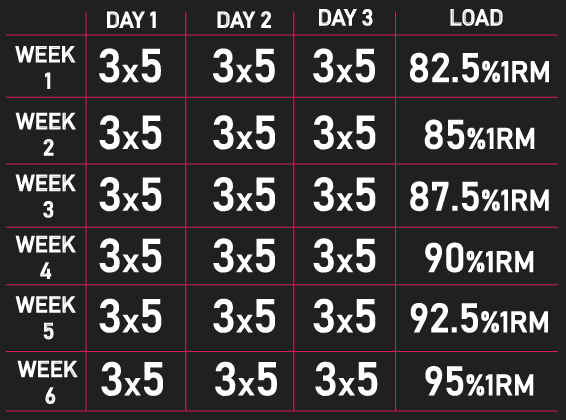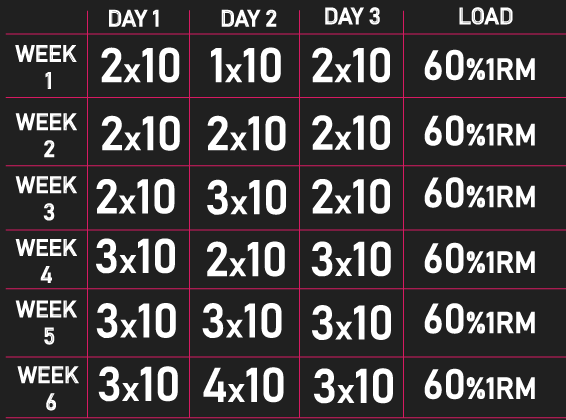
For maximizing hypertrophy, should low, moderate, or high repetition numbers be used?
Well, as we’ve mentioned in other articles, there’s a great number of studies finding loads between 80% one-rep max and 30% one-rep max produce similar muscle hypertrophy, so long as repetitions are performed to or very close to failure.
Very broadly, this equates to performing between 8 and 35 repetitions.
But, what about fewer than 8 repetitions?
Say 5 repetitions, for example. Could this still optimize hypertrophy?
For quite a while, I automatically assumed there was good evidence showing 5 repetitions could build muscle optimally.
In fact, I’ve previously said in articles reps between 5 and 35 are similarly effective for hypertrophy, provided repetitions are performed to or close to failure.
However, a new study by Vann et al. made me re-assess this belief and re-examine the research on rep ranges, and now I’m less certain if 5 repetitions could optimally build muscle.
Let us overview this study, discuss its limitations, and then detail how it relates to the overall rep range research.
New Study: 5 Reps for Hypertrophy?
Subjects
Vann et al. recruited 15 trained men with an average back squat of 167kg. For these subjects, this equated to them squatting 1.9x their bodyweight.
Protocol
Each subject had one leg assigned to a high load condition, and their other leg assigned to a high volume condition.
Both legs were trained on the unilateral leg extension and unilateral leg press, three times per week for a total of 6 weeks.
With the leg assigned to the high load condition, they performed 3 sets of 5 repetitions on both exercises every session. They also progressed load weekly by 2.5%.

During the first week, they trained with 82.5% of the pre-study one-rep maxes on both exercises, and they progressed this load by 2.5% each week such that by the 6th week, they were training with 95% of their pre-study one-rep maxes on both exercises.
With the leg assigned to the high volume condition, they performed the program below.

They trained with sets of 10 repetitions with 60% one-rep max loads. They did not progress this load whatsoever throughout the study. By the 6th week, they were still training with 60% of their pre-study one-rep maxes.
What they did progress, however, was the volume (in the form of sets).
During the first weeks, they mainly performed 1 to 2 sets per exercise. But during the later weeks, they mainly performed 3 or 4 sets per exercise.
Measurements
Before and after the study, a range of measurements was assessed.
The main one we’ll explore is cross-sectional area of the vastus lateralis (which is an indictor of vastus lateralis hypertrophy).

Results
After the study, the researchers found increases in vastus lateralis cross-sectional area were greater for the high volume condition versus the high load condition. In fact, the high load condition saw on average no gains.

In other words, performing sets of 10 reps with a 60% one-rep max load, and progressing set numbers but not load, produced more hypertrophy than performing sets of 5 reps and progressing load.
Discussion
These findings are highly interesting, especially when considering how the two conditions differed in the set numbers they performed and how close to failure they trained.
Exploring set numbers first, despite the high volume condition progressing their set numbers across the 6 weeks, they still ultimately did not perform as many sets as the high load condition.
The high load condition performed 18 weekly sets for the quads, whereas the high volume condition only averaged 15 weekly sets for the quads.
Despite these differences, the high volume condition still experienced more growth.
As for how close to failure they trained, we know the high volume condition involved performing sets of 10 reps with a 60% one-rep max load, and they did not progress load at all throughout the study.
As you can probably perform 20 maximum repetitions, give or take a few, with a 60% one-rep max load, this group would have been training 10 or so reps away from failure per set. This is very far from failure.
Opposingly, the high load condition performed sets of 5 reps with loads that likely meant they were largely training 0 to 3 reps away from failure per set.
Despite the high volume condition training much further from failure than the high load condition, they experienced more vastus lateralis hypertrophy.
Before moving on, if you’re curious about creating an effective training program for muscle hypertrophy, our high quality partner Alpha Progression can help. It can generate a highly effective program for you, track your workouts live with in-built progression recommendations, provide graphs displaying your long term progress, and it has a massive exercise database with more than 550 exercises.
Click HERE (the link opens in a new tab) to get a free 2 week trial of the apps features. If you like it and go beyond, the link also gives you 20% off a subscription!
We never promote trash at the House of Hypertrophy, so rest assured the app is high quality. The reviews speak to this, 4.8 starts (based on more than 7,000 reviews) on Google play, and 4.9 stars in Apple’s store (based on nearly 400 ratings).
Limitations/Considerations
Let us now go through some limitations and considerations with this Vann et al. study, and then try and figure out how it fits into the rest of the literature.
Firstly, we know that by the end of the study, the high volume condition saw greater increases in vastus lateralis cross-sectional area versus the high load condition.
These after study measurements were taken 3 days after the final training session. However, the researchers also took this measurement again 10 days after the final training session.
For the high volume condition, they saw a numerical decrease in average vastus lateralis cross-sectional area from 3 days to 10 days after the final training session. Now, this change in cross-sectional area from 3 to 10 days after the final session was not classified as statistically signficant. Even so, as the subjects did not train in these days after the final session, this numerical decrease in muscle size can likely just be attributed to detraining.

However, for the high load condition, they saw a numerical increase in average vastus lateralis cross-sectional area from 3 days to 10 days after the final training session. Now, this change in cross-sectional area from 3 to 10 days after the final session was not classified as statistically signficant, but it’s nonetheless difficult to say why the numerical average did increase given they were not training. Perhaps it was some sort of delayed supercompensation thing.

Overall, I don’t really think any of this changes the interpretation of the study. After all, 3 days after the final training session, the high volume condition still experienced more vastus lateralis hypertrophy than the high load condition. I just nonetheless thought it would be worth sharing this slightly peculiar finding.
The second limitation/consideration is the study only included 15 trained men, which like most resistance training studies, is a very small sample size. Larger sample sizes would likely be more informative and strengthen the data.
As a final limitation/consideration, the study was only 6 weeks, which is on the shorter side of typical resistance training studies we see.
Hypertrophy is not a quick process, especially in trained individuals, so it would be interesting to see how this study design plays out in the longer term.
Takeaway and the Rest of the Research
Moving forward, what are the potential takeaway from this Vann et al. study, and how does it relate to the rest of the literature?
Two potential takeaway are that maybe there could be something special about progressing set numbers for hypertrophy and/or 5 reps are simply suboptimal for hypertrophy.
The first one, that there’s some special about progressing set numbers for hypertrophy, is difficult to verify. There simply is no other research (I’m aware of) exploring how progressing set numbers over weeks compares to training with the same number of weekly sets. As a result, there really is not much else to comment here, we can only hope that future research provides further insight.
As for the second one, could 5 reps simply be suboptimal for hypertrophy?
What does the rest of the research say?
The table below summarizes all the current research (I’m aware of) exploring how 5 or so reps compares to higher rep numbers for hypertrophy. (study one, study two, study three, study four, and study five)

I should note all studies had subjects perform their reps to or very close to failure.
All of them indicate 5 or so reps were similarly effective to higher rep numbers for hypertrophy, indicating 5 or so reps might be perfectly optimal for hypertrophy.
However, all but one of them also had confounders.
More precisely, the subjects training with 5 or so reps performed more sets per exercise and/or used longer rest intervals between sets than the subjects training with higher rep numbers.
In many cases, performing more sets per exercise and resting longer between sets (particularly resting longer between sets of compound exercises) seems to be better for hypertrophy.
Thus, I think we could argue much of these studies were biased towards the subjects training with 5 or so reps.
If set numbers and rest interval durations were equated between all subjects, maybe training with 5 reps would have been suboptimal compared to training with higher rep numbers.
Now, one study by Weiss et al. did actually have all subjects train with the same set numbers and rest interval durations.
This study did actually find that 3-5 reps were similarly effective to 13-15 reps and 23-25 reps for building muscle.
Nevertheless, combining the Vann et al. study with the rest of this overall data, it’s clear to see it is far from crystal clear as to whether 5 reps can truly be optimal and efficient for hypertrophy.
More research is going to be highly valuable and insightful.
Final Words
At the end of the day, it’s really your choice on how you interpret all the data we’ve overviewed.
If your main goal is to maximize hypertrophy, and you’ve been training with 5 reps and experiencing perfectly fine hypertrophy, I don’t think there’s any solid reason to change anything.
However, if you have been experiencing subpar hypertrophy from sets of 5 and/or you’d just like to err on the side of caution to ensure you’re maximizing hypertrophy most efficiently, it might be sensible to avoid training with 5 reps, at least for the time being until there’s further future research.
As noted at the start of this article, there’s a good number of studies demonstrating with all other training variables equal, 8-35 reps are similarly effective for building muscle so long as repetitions are performed to or close to failure. As a result, it may be sensible to stay within this repetition range.
Remember to feel free to check out the Alpha Progression App if you’re interested. Also feel free to check out our free bench press e-book below.

